Terminology: Tail Lift
It took a surprisingly long time for Rickenbacker to come up with a dedicated bass bridge. When the first 4000 prototype was built in 1957, it used a stock six-string guitar bridgeplate and bridge modified for four strings. That makes sense: it was a prototype, so you use what you have on hand, right?

And when you see it in action, like above, I mean…it works well enough? Just cause you have six holes in the bridgeplate and six holes in the bridge cradle to hold six saddles doesn’t mean you have to use them all, right? And again, for a prototype that makes sense. Only the photo above isn’t from the prototype…it’s from a 1961 production guitar.
But finally in 1963–a full SIX YEARS after they started building bass guitars—Rickenbacker introduced a proper bass bridge. Consisting of a chrome plated sand-cast aluminum base with a built in adjustable mute and a drop-in bridge with adjustable saddles, it was actually a pretty elegant design.

If we’re being honest, it’s really not that conceptually different from the modified guitar bridge it replaced—a bridgeplate that attaches to the body, and a removable saddle assembly that sits on top of it. Like so:

Pay special note to those three screw holes that attach the base to the guitar body. That’s going to be important in a minute.
This is where we need to very briefly talk about string tension. On an archery bow, the effect of this tension is easy to see: the more you pull back the bowstring—the more tension you put on it—the more the bow bends inward in response to that tension. The same forces are in play on your guitar neck.
Basically, string tension is constantly conspiring to turn your guitar into a banana. That’s why we have truss rods in guitar necks—the weakest structural point. Their job is to offset this tension by “pushing” in the opposite direction and keeping the neck straight.
Your anchor points are weak points as well. Why do you think so many basses have string-through bridges? Why are bass tuner posts so much thicker than guitar tuner posts? To hold up against the tension and fight the banana!
And that cast aluminum bridge was strong enough to fight the banana. You don’t find tail lift on those bridges. But in 1973 they changed the bridge material from aluminum to zinc, and that’s when the problem started.
And Rickenbacker knew from the jump that the zinc base wasn’t going to be as strong as the aluminum one it replaced. How do we know that? We know that because they added two more screws—further back towards the end—to help hold it down.

But it still wasn’t enough. And so it didn’t take long for a new term to enter the Rickenbacker lexicon: tail lift.
I won’t say the extra screws didn’t do anything. They did! But what they did was move the bend/pivot point further back, not eliminate it. Look, the best way to tell is to show:

See how the “tail” of the bridge is “lifting” away from the body? And from this angle the mechanics are pretty clear. String tension is pulling the string ends towards each other and the tension (over time) is just ever-so-slightly stronger than the bridge base material. And so the bridge is bending upwards right at the point where those two extra screws are anchoring it to the body.
Pretty much every 4001 made from 1973 on has some degree of tail lift. The example above is “moderate”. Here’s a mild case:

And here’s a pretty severe case:
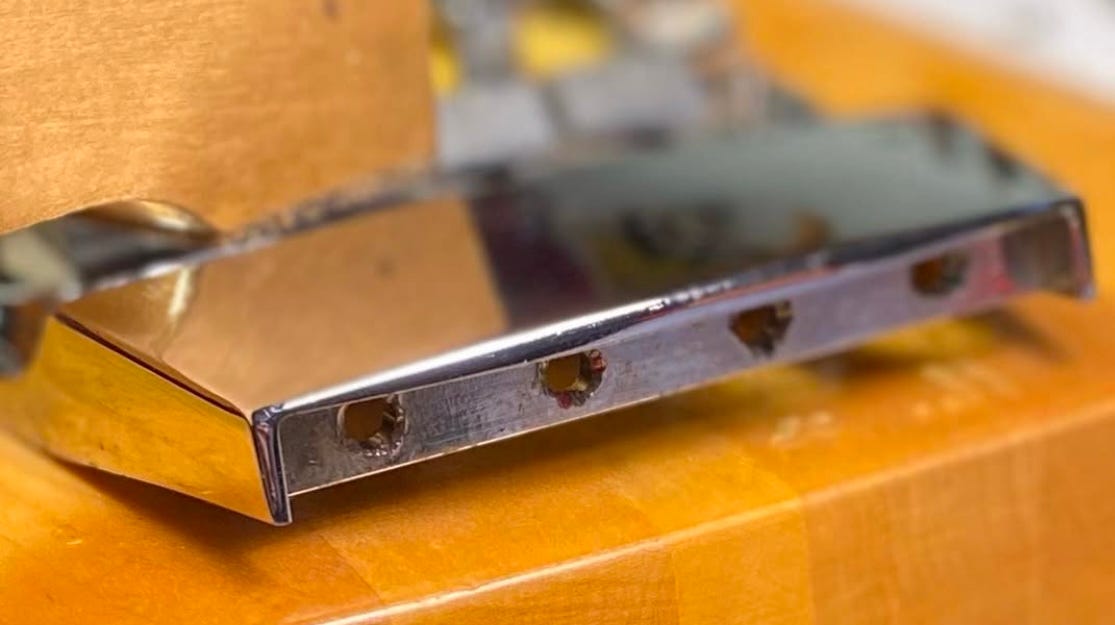
For some reason the black bridges on the BH/BT guitars seem to be especially susceptible. It is hypothesized that the heat involved in the powder coating process weakens the bridge…and that’s as good a guess as any?

And, to be fair, it wasn’t just the 4001. The same bridge was used on the 3000/3001 and 4002, with the same results.

When the 4003 launched in 1980, it got a beefier neck and different truss rod orientation to handle the increased tension of roundwound strings—remember that using roundwounds on your 4001 instead of flatwounds would void the warranty! Did they change the metallurgy of the bridge to handle the extra tension as well? Nope. They just added more screws to the base!
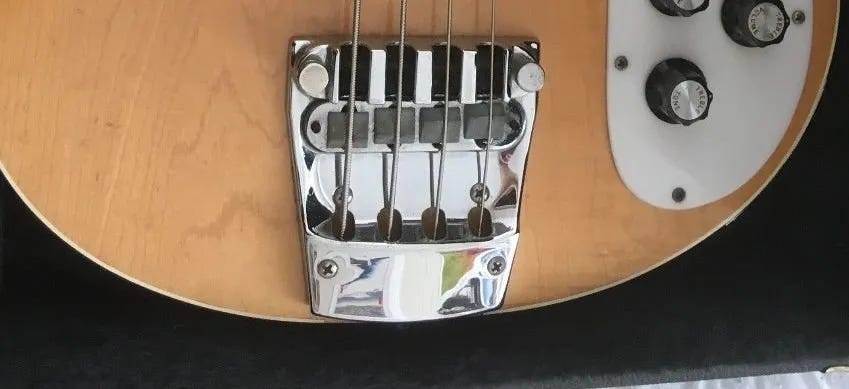
Those screws would go away in early 1989. So they fixed it? Well, here’s an early 1990 4003…
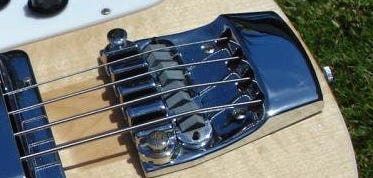
…and here’s a 2005:

So…no. And you may say “those don’t look so bad”, and they don’t! But remember, tail lift is a product of tension over time. Give ‘em another 20 years…
A solution was finally introduced in 2019 with a whole new bridge: the V2. The V2 resolved two long-standing complaints about the Rickenbacker bass bridge: limited adjustability and…tail lift.
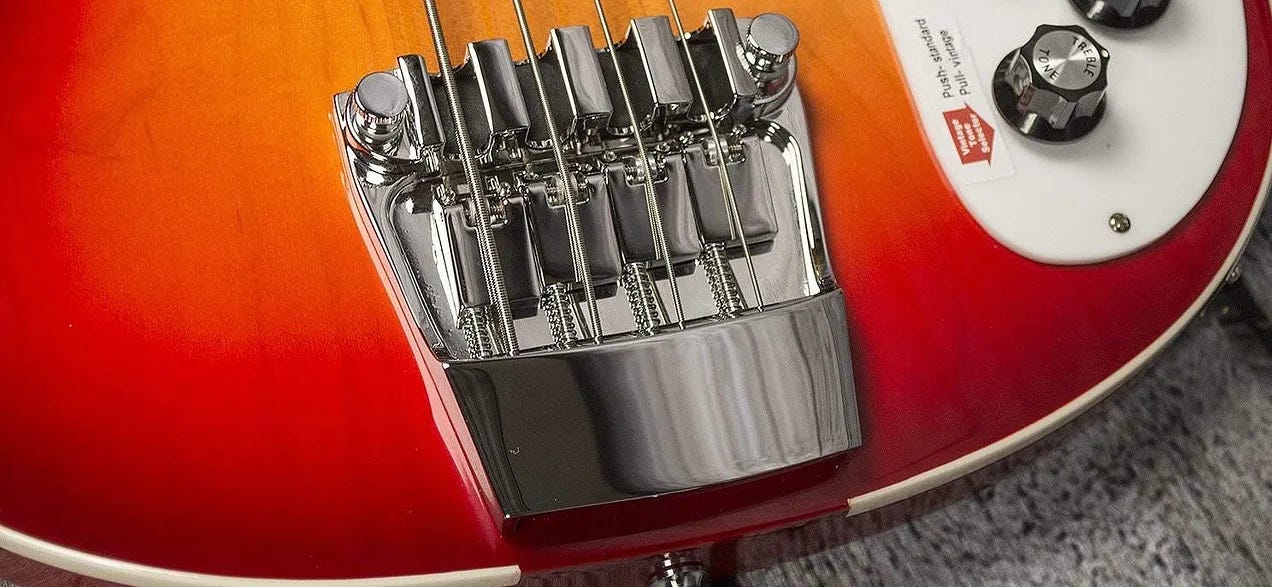
The drop-in bridge unit was replaced by 4 individual saddles that could be adjusted both back to front and up and down, and the string anchor was removed entirely from the base unit. Again, easier to show than tell:

Let’s look at the holes in the installation template. The big holes are the holes from the old bridge—the three under the saddles and the two behind. The small holes are for the new bridge. The four up top hold the big base unit in place, and the four down below hold the string anchor—the dull block with four holes in it on the left. THAT anchor is what holds the string ball ends—completely separate from the big base unit. No attachment to the base unit means no string tension on the base unit means…no more tail lift. The end.
It’s worth mentioning that the 4001C64 got a three mounting screw version of the bridge for cosmetic purposes. It is no more or less prone to tail lift than any other bass, but the pivot point changed due to the lack of the two extra screws.
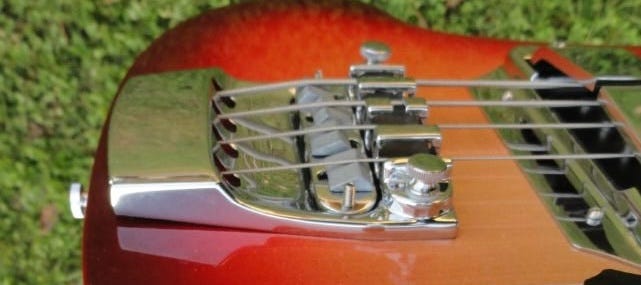
Now look: it is VERY rare for tail lift to get so bad it renders the guitar unplayable. I won’t say it never happens—and it’s far more likely to happen on a black powder coated bridge than a chrome one—but you’ll probably never come across one that far gone. Those you want to avoid. But a little bit of tail lift is to be expected, not panicked over. It’s part of the experience!


I have two 73’s from March and June with original hardware including bridge/tail pieces on them. I’d say around a 1/16”of tail lift on the June. March is 1/16” at most of tail lift. Woody’s ‘74 4000 has 1/8” and the ‘75 4001s has 1/16” tail lift. Woody’s is this probably the worst of the four.
Now, if they’d just come out with a muteless option…..😉
All my 4000 and 4002 basses got aftermarket bridges installed. (hipshot and Starz)